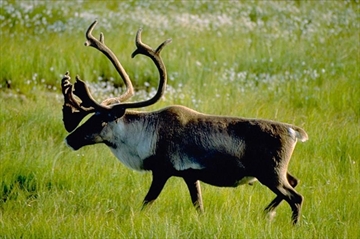Marks handed out in caribou report
Source: southwesternontario.ca
Photo: A Woodland caribou bull in Torngats is seen in this undated handout photo. Manitoba and Saskatchewan come out on top of a mediocre class in a new review of how Canada’s provinces and territories are protecting vulnerable woodland caribou. The Canadian Press/HO, CPAWS – Mike Bedell
Written by: Bob Weber, The Canadian Press
Edmonton, Manitoba and Saskatchewan come out on top of a mediocre class in a new review of how Canada’s provinces and territories are protecting vulnerable woodland caribou. “They’ve been taking it seriously,” said Eric Hebert-Daly, national director of the Canadian Parks and Wilderness Society.
“They’ve taken the bull by the horns and really driven things.”
Woodland caribou are considered a strong indicator of a healthy boreal forest. While there remain about 32,000 woodland caribou across the country, their habitat is increasingly fragmented and degraded by industrial development and many herds are in danger of disappearing.
The federal government has written a recovery strategy for the animals that requires the provinces to preserve enough habitat to keep them on the landscape. Scientists say habitat for woodland caribou can be no more than 35 per cent disturbed for their numbers to remain stable.
Some provinces have stepped up, said Hebert-Daly.
In November, Manitoba created a 900-square-kilometre protected area, all of which lies within caribou range.
Saskatchewan now requires new forest management plans to demonstrate at least 65 per cent of caribou habitat will be kept undisturbed.
In Newfoundland and Labrador, the new Mealy Mountains National Park will permanently protect at least one caribou herd. Quebec added 5,000 square kilometres to its roster of protected spaces, some of which is home to caribou.
And even one-time environmental bad-boy Alberta has stopped selling energy leases on caribou habitat. Other provinces? Not so much, Hebert-Daly said.
“Ontario has really taken no meaningful action since the very beginning,” he said.
Eleven of the province’s 13 caribou ranges are so degraded they won’t support caribou into the future. The society is in the middle of a court case against the provincial government over what it says are laws exempting industries from core protection provisions under its Endangered Species Act.
And Hebert-Daly said British Columbia remains focused on stopping caribou decline by shooting wolves, while at the same time encouraging gas development on caribou habitat.
But even with the good news, Canada’s performance this year on caribou recovery has been spotty at best, Hebert-Daly said.
“We’re talking about an increase in protection of caribou habitat of one per cent since last year. These are important steps, but they’re still very, very small and aren’t at the rate they need to be to get to where we need to be.”
Federal legislation requires provinces to have their protection strategies and range plans in place by 2017. The report suggests only Saskatchewan is on track to meet that deadline. Hebert-Daly said protecting caribou protects an entire ecosystem.
“The impact on saving this particular species and its habitat has a domino effect on all the other species in the boreal forest,” he said.
“If you’re able to protect their habitat, you create a bit of an umbrella effect. You’re actually protecting the ecosystems that sustain a whole lot of other species.”
